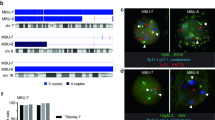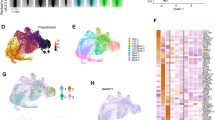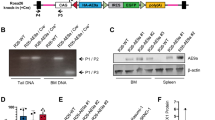Abstract
Human tumor cell lines are powerful tools for investigating basic and applied aspects of cell biology. Leukemia–lymphoma cell lines have been instrumental in the cytogenetic and molecular analysis of recurring chromosome rearrangements, notably translocations and inversions, thus illuminating the pathogenesis of hematological malignancy. Chromosomal translocations targeting the MLL gene at 11q23 have come to represent a paradigm in acute leukemias. These translocations result in the in-frame joining of the MLL gene with a partner gene to generate unique fusion proteins of putatively novel function. More than 30 partner genes that participate with MLL in the more than 60 known 11q23 translocations have been reported. Cell lines provide territory to both explore the detailed structures of 11q23 translocations and investigate the leukemogenic activities of MLL fusion proteins. We review here the leukemia cell lines that have been described to carry 11q23 translocations and MLL fusion genes. Except for the t(10;11)(p12;q23), each of the following relatively frequent 11q23/MLL translocations is represented by one or more cell lines: 16 cell lines with t(4;11)(q21;q23), two cell lines with t(6;11)(q27;q23), seven cell lines with t(9;11)(p22;q23), and eight cell lines with t(11;19)(q23;p13). For each of three rare translocations, one cell line has been reported: t(5;11)(q15;q23), t(11;16)(q23;p13), and t(X;11)(q13;q23). Of these 36 cell lines with 11q23 translocations, 17 have been made available to us; we confirmed the occurrence of the alterations reported in these cell lines at the chromosomal and/or gene level. A second type of MLL gene alteration is the partial tandem duplication (PTD), which occurs in acute myeloid leukemia (AML). We found four AML cell lines with an MLL PTD; one acute lymphoblastic leukemia-derived cell line was reported to show a partial nontandem duplication. Finally, a third rearrangement involves intrachromosomal amplification of the unrearranged MLL gene leading to multiple copies of the gene and (presumably) increased expression. Three cell lines carrying such MLL amplifications have been described. The availability of these cell lines as model systems provides the opportunity to explore the altered expression or functions of MLL genes and their partners in oncogenesis.
This is a preview of subscription content, access via your institution
Access options
Subscribe to this journal
Receive 12 print issues and online access
$259.00 per year
only $21.58 per issue
Buy this article
- Purchase on Springer Link
- Instant access to full article PDF
Prices may be subject to local taxes which are calculated during checkout

Similar content being viewed by others
References
Drexler HG (ed). The Leukemia–Lymphoma Cell Line Facts Book. Academic Press: San Diego, 2000.
Drexler HG, MacLeod RAF, Borkhardt A, Janssen JWG . Recurrent chromosomal translocations and fusion genes in leukemia–lymphoma cell lines. Leukemia 1995; 9: 480–500.
Drexler HG, MacLeod R . Leukemia–lymphoma cell lines as model systems for hematopoietic research. Ann Med 2003; 35: 401–412.
Mitelman F, Johansson B, Mertens F (eds). Mitelman Database of Chromosome Aberrations in Cancer. 2003. http://cgap.nci.nih.gov/Chromosomes/Mitelman.
Huret JL . 11q23 rearrangements in leukaemia. Atlas Genet Cytogenet Oncol Haematol 2001. http://www.infobiogen.fr/services/chromcancer/Anomalies/11q23ID1030.html.
Bohlander SK . Fusion genes in leukemia: an emerging network. Cytogenet Cell Genet 2000; 91: 52–56.
Ayton PM, Cleary ML . Molecular mechanisms of leukemogenesis mediated by MLL fusion proteins. Oncogene 2001; 20: 5695–5707.
DiMartino JF, Cleary ML . MLL rearrangements in haematological malignancies: lessons from clinical and biological studies. Br J Haematol 1999; 106: 614–626.
Ernst P, Wang J, Korsmeyer SJ . The role of MLL in hematopoiesis and leukemia. Curr Opin Hematol 2002; 9: 282–287.
Marschalek R, Nilson I, Löchner K, Greim R, Siegler G, Greil J et al. The structure of the human ALL-1/MLL/HRX gene. Leukemia Lymphoma 1997; 27: 417–428.
Reichel M, Gillert E, Nilson I, Siegler G, Greil J, Fey GH et al. Fine structure of translocation breakpoints in leukemic blasts with chromosomal translocation t(4;11): the DNA damage-repair model of translocation. Oncogene 1998; 17: 3035–3044.
Ridge SA, Wiedemann LM . Chromosome 11q23 abnormalities in leukaemia. Leukemia Lymphoma 1994; 14: 11–17.
Milne TA, Briggs SD, Brock HW, Martin ME, Gibbs D, Allis CD et al. MLL targets SET domain methyltransferase activity to Hox gene promoters. Mol Cell 2002; 10: 1107–1117.
Armstrong SA, Staunton JE, Silverman LB, Pieters R, den Boer ML, Minden MD et al. MLL translocations specifiy a distinct gene expression profile that distinguishes a unique leukemia. Nat Genet 2002; 30: 41–47.
Hilden JM, Kersey JH . The MLL (11q23) and AF-4 (4q21) genes disrupted in t(4;11) acute leukemia: molecular and clinical studies. Leukemia Lymphoma 1994; 14: 189–195.
Cesano A, O'Connor R, Lange B, Finan J, Rovera G, Santoli D . Homing and progression patterns of childhood acute lymphoblastic leukemias in severe combined immuno-deficiency mice. Blood 1991; 77: 2463–2474.
Gobbi A, Di Berardino C, Scanziani E, Garofalo A, Rivolta A, Fontana G et al. A human acute lymphoblastic leukemia line with the t(4;11) translocation as a model of minimal residual disease in SCID mice. Leukemia Res 1997; 21: 1107–1114.
Cohen A, Grunberger T, Vanek W, Dube ID, Doherty PJ, Letarte M et al. Constitutive expression and role in growth regulation of interleukin-1 and multiple cytokine receptors in a biphenotypic leukemic cell line. Blood 1991; 78: 94–102.
Tang RP, Delmer A, Faussat AM, Marie JP, Ajchenbaum-Cymbalista F . Inducible expression of the cell cycle inhibitor p27Kip1 during serum deprivation provides a clue to resistance of MLL-AF4 lymphoblastic cells to apoptosis. Blood 1999; 94: 485a.
Bertrand FE, Vogtenhuber C, Shah N, LeBien TW . Pro-B-cell to pre-B-cell development in B-lineage acute lymphoblastic leukemia expressing the MLL/AF4 fusion protein. Blood 2001; 98: 3398–3405.
Zhou M, Yeager AM, Smith SD, Findley HW . Overexpression of the MDM2 gene by childhood acute lymphoblastic leukemia cells expressing the wild-type p53 gene. Blood 1995; 85: 1608–1614.
Tani A, Tatsumi E, Nakamura F, Kumagai S, Kosaka Y, Sano K et al. Sensitivity to dexamethasone and absence of bcl-2 protein in Burkitt's lymphoma cell line (Black92) derived from a patient with acute tumor lysis syndrome: comparative study with other BL and non-BL lines. Leukemia 1996; 10: 1592–1603.
Iida S, Saito M, Okazaki T, Seto M, Yamamoto K, Akao Y et al. Phenotypic and genotypic characterization of 14 leukemia and lymphoma cell lines with 11q23 translocations. Leukemia Res 1992; 16: 1155–1163.
Yamamoto K, Seto M, Iida S, Komatsu H, Kamada N, Kojima S et al. A reverse transcriptase-polymerase chain reaction detects heterogenous chimeric mRNAs in leukemias with 11q23 abnormalities. Blood 1994; 83: 2912–2921.
Stong RC, Korsmeyer SL, Parkin JL, Arthur DC, Kersey JH . Human acute leukemia cell line with the t(4;11) chromosomal rearrangement exhibits B lineage and monocytic characteristics. Blood 1985; 65: 21–31.
Hayashi Y, Kawamura M, Kobayashi S, Moriwa K, Kobayashi M, Bessho F et al. Establishment and characterization of cell lines derived from childhood leukemias. Int J Hematol 1993; 57: 124.
Greil J, Gramatzki M, Burger R, Marschalek R, Peltner M, Trautmann U et al. The acute lymphoblastic leukaemia cell line SEM with t(4;11) chromosomal rearrangement is biphenotypic and responsive to interleukin-7. Br J Haematol 1994; 86: 275–283.
Drexler HG, Dirks WG, MacLeod RAF, Quentmeier H, Steube KG, Uphoff CC (eds). DSMZ Catalogue of Human and Animal Cell Lines, 8th edn. Braunschweig, Germany: DSMZ, 2001.
Lange B, Valtieri M, Santoli D, Caracciolo D, Mavilio F, Gemperlein I et al. Growth factor requirements of childhood acute leukemia: establishment of GM-CSF-dependent cell lines. Blood 1987; 70: 192–199.
Imamura T, Morimoto A, Ikushima S, Kakazu N, Hada S, Tabata Y et al. A novel infant acute lymphoblastic leukemia cell line with MLL-AF5q31 fusion transcript. Leukemia 2002; 16: 2302–2308.
Kakuda H, Sato T, Hayashi Y, Enomoto Y, Takayama J, Ohirta M et al. A novel human leukaemic cell line, CTS, has a t(6;11) chromosomal translocation and characteristics of pluripotent stem cells. Br J Haematol 1996; 95: 306–318.
Quentmeier H, Reinhardt J, Zaborski M, Drexler HG . MLL partial tandem duplications in acute leukemia cell lines. Leukemia 2003; 17: 980–981.
Tanabe S, Zeleznik-Le NJ, Kobayashi H, Vignon C, Espinosa III R, LeBeau MM et al. Analysis of the t(6;11)(q27;q23) in leukemia shows a consistent breakpoint in AF6 in three patients and in the ML-2 cell line. Genes Chromosomes Cancer 1996; 15: 206–216.
Iida S, Seto M, Yamamoto K, Komatsu H, Tojo A, Asano S et al. MLLT3 gene on 9p22 involved in t(9;11) leukemia encodes a serine/proline rich protein homologous to MLLT1 on 19p13. Oncogene 1993; 8: 3085–3092.
Matsuo Y, MacLeod RAF, Uphoff CC, Drexler HG, Nishizaki C, Katayama Y et al. Two acute monocytic leukemia (AML-M5a) cell lines (MOLM-13 and MOLM-14) with interclonal phenotypic heterogeneity showing MLL-AF9 fusion resulting from an occult chromosome insertion, ins(11;9)(q23;p22p23). Leukemia 1997; 11: 1469–1477.
Ziegler-Heitbrock HWL, Thiel E, Fütterer A, Herzog V, Wirtz A, Riethmüller G . Establishment of a human cell line (Mono Mac 6) with characteristics of mature monocytes. Int J Cancer 1988; 41: 456–461.
Kato Y, Ogura M, Okumura M, Morishima Y, Horita T, Ohno R et al. Establishment of peroxidase positive, human monocytic leukemia cell line (NOMO-1) and its characteristics. Acta Haematol Jpn 1986; 49: 277.
Quentmeier H, Dirks WG, MacLeod RAF, Reinhardt J, Zaborksi M, Drexler HG . Expression of HOX genes in acute leukemia cell lines with and without MLL translocations. Leukemia Lymphoma, (in press).
Tsuchiya S, Yamabe M, Yamaguchi Y, Kobayashi Y, Konno T, Tada K . Establishment and characterization of a human acute monocytic leukemia cell line (THP-1). Int J Cancer 1980; 26: 171–176.
Ikeda T, Sasaki K, Ikeda K, Yamaoka G, Kawanishi K, Kawachi Y et al. A new cytokine-dependent monoblastic cell line with t(9;11)(p22:q23) differentiates to macrophages with macrophage colony-stimulating factor (M-CSF) and to osteoclast-like cells with M-CSF and interleukin-4. Blood 1998; 91: 4543–4553.
Hayashi Y, Honma Y, Niitsu N, Taki T, Bessho F, Sako M et al. SN-1, a novel leukemic cell line with t(11;16)(q23;p13): myeloid characteristics and resistance to retinoids and vitamin D3. Cancer Res 2000; 60: 1139–1145.
Katz F, Gibbons B, Chessells J . An early B cell line with a variant 11;19 translocation. Leukemia Lymphoma 1991; 4: 397–404.
Matsuo Y, Drexler HG . Establishment and characterization of human B cell precursor-leukemia cell lines. Leukemia Res 1998; 22: 567–579.
Smith SD, McFall P, Morgan R, Link M, Hecht F, Cleary M et al. Long-term growth of malignant thymocytes in vitro. Blood 1989; 73: 2182–2187.
Karpas A, Hayhoe FG, Greenberger JS, Barker CR, Cawley JC, Lowenthal RM et al. The establishment and cytological, cytochemical and immunological characterisation of human haemic cell lines: evidence for heterogeneity. Leukemia Res 1977; 1: 35–49.
Borkhardt A, Repp R, Haas OA, Leis T, Harbott J, Kreuder J et al. Cloning and characterization of AFX, the gene that fuses to MLL in acute leukemias with a t(X;11)(q13;q23). Oncogene 1997; 14: 195–202.
Drexler HG, Dirks WG, Matsuo Y, MacLeod RAF . False leukemia–lymphoma cell lines: an update on over 500 cell lines. Leukemia 2003; 17: 416–426.
Caligiuri MA, Schichman SA, Strout MP, Mrozek K, Baer MR, Frankel SR et al. Molecular rearrangement of the ALL-1 gene in acute myeloid leukemia without cytogenetic evidence of 11q23 chromosomal translocations. Cancer Res 1994; 54: 370–373.
Schichman SA, Caligiuri MA, Gu Y, Strout MP, Canaani E, Bloomfield CD et al. ALL-1 partial duplication in acute leukemia. Proc Natl Acad Sci USA 1994; 91: 6236–6239.
Schnittger S, Kinkelin U, Schoch C, Heinecke A, Haase D, Haferlach T et al. Screening for MLL tandem duplication in 387 unselected patients with AML identify a prognostically unfavorable subset of AML. Leukemia 2000; 14: 796–804.
Steudel C, Wermke M, Schaich M, Schakel U, Illmer T, Ehninger G et al. Comparative analysis of MLL partial tandem duplication and FLT3 internal tandem duplication mutations in 956 adult patients with acute myeloid leukemia. Genes Chromosomes Cancer 2003; 37: 237–251.
Saito H, Bourinbaiar A, Ginsburg M, Minato K, Ceresi E, Yamada K et al. Establishment and characterization of a new human eosinophilic leukemia cell line. Blood 1985; 66: 1233–1240.
Hu ZB, Quentmeier H, Meyer C, Kaufmann M, MacLeod RAF, Drexler HG . New cytokine-dependent acute myeloid leukemia cell line MUTZ-11 with disomic chromosome rearrangement t(16;17). in press.
Kees UR, Campbell LJ, Ford J, Willoughby MLN, Peroni SE, Ranford PR et al. New translocation t(2;13)(p12;q34) and rearrangement of the MLL gene in a childhood leukemia cell line. Genes Chromosomes Cancer 1995; 12: 201–208.
Whitman SP, Strout MP, Marcucci G, Freud AG, Culley LL, Zeleznik-Le NJ et al. The partial nontandem duplication of the MLL (ALL1) gene is a novel rearrangement that generates three distinct fusion transcripts in B-cell acute lymphoblastic leukemia. Cancer Res 2001; 61: 59–63.
Felix CA, Megonigal MD, Chervinsky DS, Leonard DGB, Tsuchida N, Kakati S et al. Association of germline p53 mutation with MLL segmental jumping translocation in treatment-related leukemia. Blood 1998; 91: 4451–4456.
Allen RJ, Smith SD, Moldwin RL, Lu MM, Giordano L, Vignon C et al. Establishment and characterization of a megakaryoblast cell line with amplification of MLL. Leukemia 1998; 12: 1119–1127.
Knutsen T, Pack S, Petropavlovskaja M, Padilla-Nash H, Knight C, Mickley LA et al. Cytogenetic, spectral karyotyping, fluorescence in situ hybridization, and comparative genomic hybridization characterization of two new secondary leukemia cell lines with 5q deletions, and MYC and MLL amplification. Genes Chromosomes Cancer 2003; 37: 270–281.
Andersen MK, Christiansen DH, Kirchhoff M, Pedersen-Bjergaard J . Duplication or amplification of chromosome band 11q23, including the unrearranged MLL gene, is a recurrent abnormality in therapy-related MDS and AML, and is closely related to mutation of the TP53 gene and to previous therapy with alkylating agents. Genes Chromosomes Cancer 2001; 31: 33–41.
Struebel B, Valent P, Jäger U, Edelhäuser M, Wandt H, Wagner T et al. Amplification of the MLL gene on double minutes, a homogeneously staining region, and ring chromosomes in five patients with acute myeloid leukemia or myelodysplastic syndrome. Genes Chromosomes Cancer 2000; 27: 380–386.
Drexler HG . Establishment and culture of human leukemia–lymphoma cell lines. In: Freshney RI, Pfragner R (eds). Culture of Tumor Cells. New York: Wiley, 2003, in press.
Author information
Authors and Affiliations
Corresponding author
Rights and permissions
About this article
Cite this article
Drexler, H., Quentmeier, H. & MacLeod, R. Malignant hematopoietic cell lines: in vitro models for the study of MLL gene alterations. Leukemia 18, 227–232 (2004). https://doi.org/10.1038/sj.leu.2403236
Received:
Accepted:
Published:
Issue Date:
DOI: https://doi.org/10.1038/sj.leu.2403236



